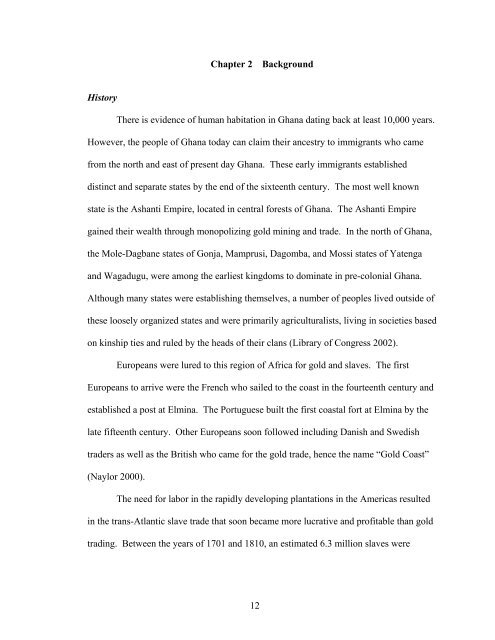i Parkia biglobosa - School of Forest Resources & Environmental ...
i Parkia biglobosa - School of Forest Resources & Environmental ...
i Parkia biglobosa - School of Forest Resources & Environmental ...
Create successful ePaper yourself
Turn your PDF publications into a flip-book with our unique Google optimized e-Paper software.
History<br />
Chapter 2 Background<br />
There is evidence <strong>of</strong> human habitation in Ghana dating back at least 10,000 years.<br />
However, the people <strong>of</strong> Ghana today can claim their ancestry to immigrants who came<br />
from the north and east <strong>of</strong> present day Ghana. These early immigrants established<br />
distinct and separate states by the end <strong>of</strong> the sixteenth century. The most well known<br />
state is the Ashanti Empire, located in central forests <strong>of</strong> Ghana. The Ashanti Empire<br />
gained their wealth through monopolizing gold mining and trade. In the north <strong>of</strong> Ghana,<br />
the Mole-Dagbane states <strong>of</strong> Gonja, Mamprusi, Dagomba, and Mossi states <strong>of</strong> Yatenga<br />
and Wagadugu, were among the earliest kingdoms to dominate in pre-colonial Ghana.<br />
Although many states were establishing themselves, a number <strong>of</strong> peoples lived outside <strong>of</strong><br />
these loosely organized states and were primarily agriculturalists, living in societies based<br />
on kinship ties and ruled by the heads <strong>of</strong> their clans (Library <strong>of</strong> Congress 2002).<br />
Europeans were lured to this region <strong>of</strong> Africa for gold and slaves. The first<br />
Europeans to arrive were the French who sailed to the coast in the fourteenth century and<br />
established a post at Elmina. The Portuguese built the first coastal fort at Elmina by the<br />
late fifteenth century. Other Europeans soon followed including Danish and Swedish<br />
traders as well as the British who came for the gold trade, hence the name “Gold Coast”<br />
(Naylor 2000).<br />
The need for labor in the rapidly developing plantations in the Americas resulted<br />
in the trans-Atlantic slave trade that soon became more lucrative and pr<strong>of</strong>itable than gold<br />
trading. Between the years <strong>of</strong> 1701 and 1810, an estimated 6.3 million slaves were<br />
12








